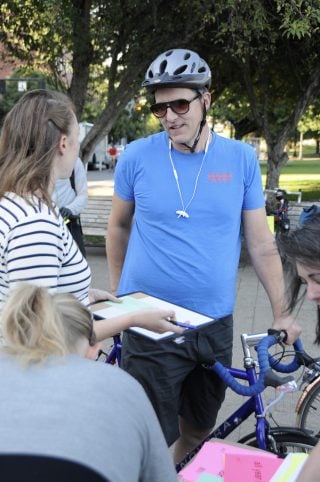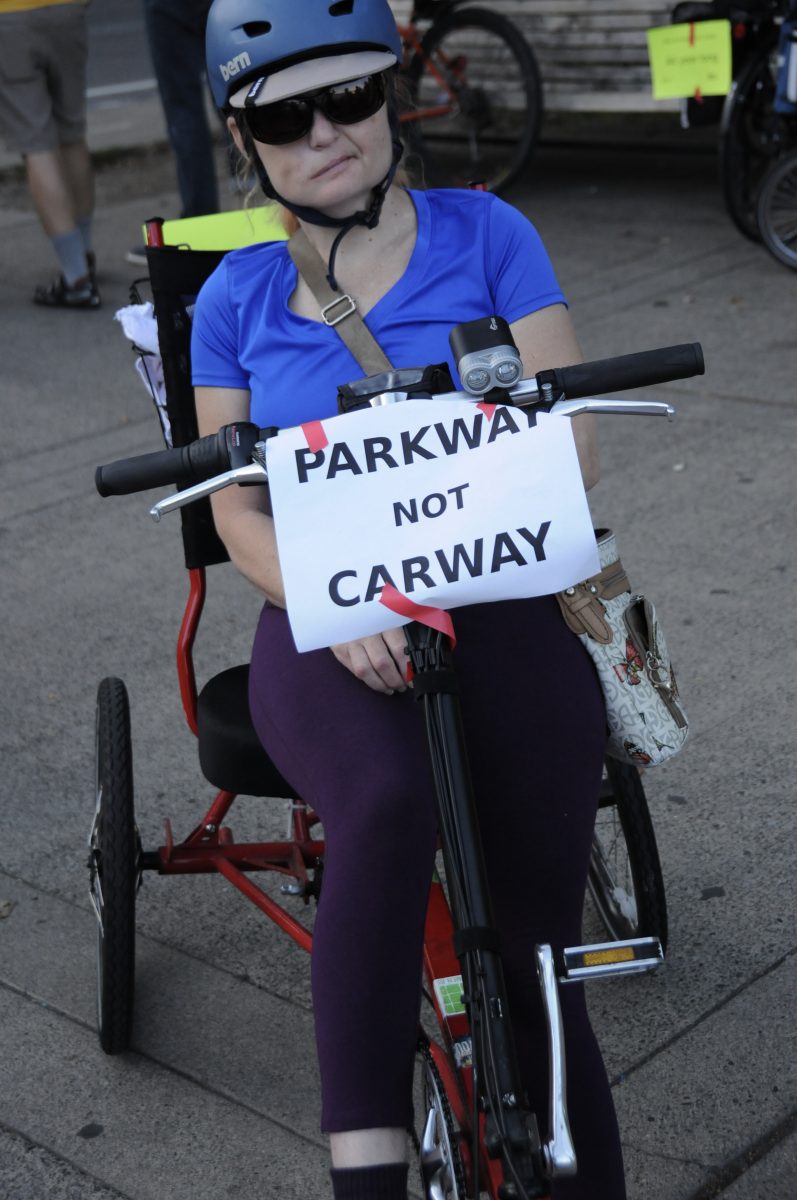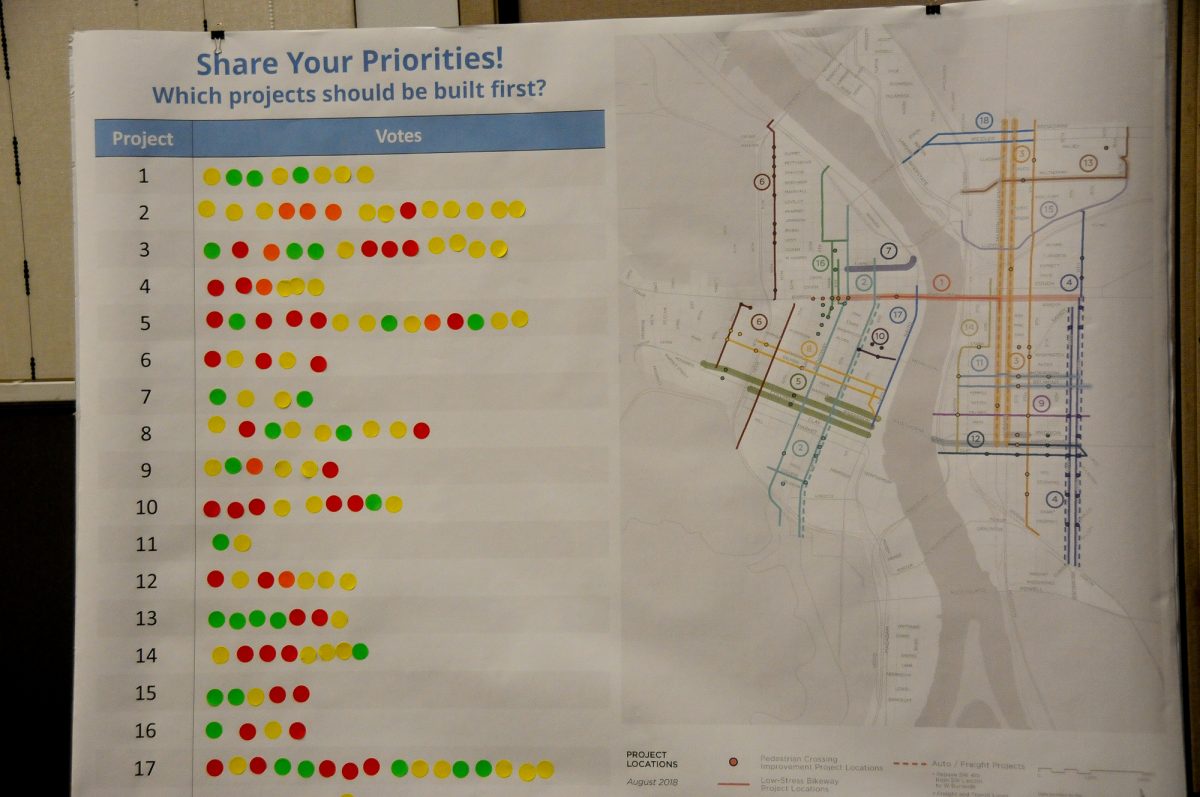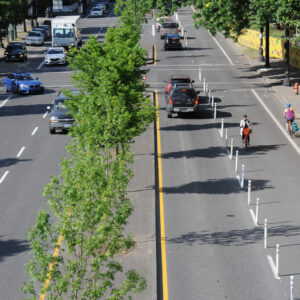
(Photos: Jonathan Maus/BikePortland)
Amid bustling, after-work traffic on Naito Parkway last night, dozens of Portlanders came together to send a message: The protected lanes known as Better Naito should stay.
The lanes are slated to be removed this weekend and aren’t scheduled to return until the start of festival season next spring.
That means people like Chris Mommsen and his young daughter Ginny won’t have a safe route to go north-south through this part of downtown. Mommsen works on SW 2nd and uses Better Naito to get between Ginny’s daycare and errands in the Pearl District. What will he do when it comes out? “There aren’t a lot of good options,” he told me. “I think they should leave it in. We need more space oriented to bikes.”
Serenity Ebert rides a trike that she uses as a mobility device. For her, having a safe and direct route through downtown is crucial. “I’d love to see Better Naito stay all year round because I don’t feel safe riding on Naito without the lane,” she shared with me. Asked what she’d do when it’s taken out, she had trouble describing a good option.
“For us it’s not just about Better Naito, it’s about all the access improvements being proposed as part of Central City in Motion.”
— Jillian Detweiler, The Street Trust
Even though a last-minute change in policy is a long-shot (more on that later), advocates for the lanes were upbeat and optimistic. The event was organized by The Street Trust. Their Executive Director Jillian Detweiler said she didn’t want the Better Naito season to end without a public action. Speaking into a megaphone from atop a park bench at Salmon Springs Fountain, Detweiler told the crowd that, “We want to tell the City of Portland that we need safe and convenient bike facilities downtown and in the central city all year long. For us it’s not just about Better Naito, it’s about all the access improvements being proposed as part of Central City in Motion.”
Central City in Motion is the Bureau of Transportation’s effort to prioritize a list of projects that will redesign streets so they work better for biking, walking, and transit. Better Naito is on the current list of potential projects and will likely be a frontrunner for early implementation.
While planning last night’s event, Detweiler reached out to the leaders of Bike Loud PDX to make sure it was a collaborative action. Bike Loud was formed just a few years ago to be a more grassroots and aggressive (louder) voice for cycling access in Portland (a role The Street Trust used to occupy), so it’s noteworthy to see the groups working together. (Detweiler shared via email this morning that, “We have not discussed a relationship going forward, but I think this was a good model.”)

Bike Loud Co-chair Catie Gould also spoke at the event. She was part of 100 people who formed a human-protected bike lane to protest Better Naito’s removal last year and she expressed some frustration that it was being removed once again. “A few things are different from last year that should give you optimism,” she said. “We have a new transportation commissioner in Chloe Eudaly and we’re hoping PBOT will get strong political leadership.”
Advertisement

Gould also mentioned the Central City in Motion projects (which weren’t on the table last year). “At a time we’re poised to invest tens of millions of dollars into making protected, separated bike infrastructure downtown,” she said, “it makes it even harder to justify why we’re spending money to take out such an obvious and simple solution.” Gould also made the point that we don’t lack the technical skills to create protected lanes on Naito, what we lack is the political will.
The good news is there are signs that Portland’s political will around these type of projects is growing. The bad news is, there doesn’t appear to be enough of it to save Better Naito this year.

That was the sentiment shared by Commissioner Chloe Eudaly’s Chief of Staff Marshall Runkel, who stopped by the rally on his bike ride home. New to the PBOT commissioner role, Runkel is still learning about the issues and he spent much of his time at last night’s event talking with Bike Loud Co-chair Emily Guise. During my conversation with him, Runkel seemed very supportive of the project, but he was candid about its chances of staying in through the winter.
“We just don’t have the resources or time to do a last-minute save this year,” Runkel said. He was referring to political capital, not funding resources. Right now Eudaly is in a pitched battle over tenants rights and Runkel said the time and effort it would take to handle another potential controversial issue like reversing course on Better Naito, just isn’t feasible right now.
But Runkel said it’s definitely possible in 2019. “We’ll plan to dig-in… It’s possible [it could stay in for good] next year.”
For advocates like Gould, the marching orders are clear: build political support over the winter. “We have a transformational change coming to our transportation system. This is great time to have a conversation about what we want,” she told the crowd, “But it doesn’t happen without strong advocates.”
After the rally, we rode up and down Naito as a group and made our way to the second (of two) Central City in Motion open houses held at OMSI. At this point, PBOT is looking for final bits of feedback about which of the 18 proposed projects have the most potential to be “transformative”. In an exercise where open house attendees used dots to show votes, the Naito project (#17) ranked highest.
— Jonathan Maus: (503) 706-8804, @jonathan_maus on Twitter and jonathan@bikeportland.org
Never miss a story. Sign-up for the daily BP Headlines email.
BikePortland needs your support.












Thanks for reading.
BikePortland has served this community with independent community journalism since 2005. We rely on subscriptions from readers like you to survive. Your financial support is vital in keeping this valuable resource alive and well.
Please subscribe today to strengthen and expand our work.
Eudaly is ***Personal insult deleted. That’s not acceptable Bert. – Jonathan*** She will undoubtly make transportation in Portland worse, just as she’s done to our housing situation.
What has she done to make our housing situation worse?
Eudaly led the council to imposed additional regulatory burdens on landlords (such as tenant relocation allowances) that will cost them money, which they will have to pass on to tenants. Eudaly has proposed additional regulatory burdens on landlords (new screening criteria that limits landlords ability to select tenants who can actually afford what they seek to rent) that will cost landlords money, which they will have to pass on to tenants. Some landlords are already selling out, and others are leery of entering the market and building new units. These actions reduce the availability of housing, thus making the housing situation worse.
I used to be a landlord with one single-family dwelling; it was lots of work and not very profitable so I sold out. If you think there is a lack of affordable housing and that being a landlord is the road to riches I suggest you buy a house or apartment complex and rent your units for bargain prices to those in need.
There is a misconception that the price of rental housing is based on the landlords costs. In reality over the long term rents are set by price able to be paid by tenants. Since wages for most of the middle and lower middle classes have been stagnant ( in constant dollars) since 2000 that will over time apply a downward pressure on rents regardless of the cost structure of Landlords. If they can’t make money at market rents they will have to sell the units at a loss and the new owner will have a lower cost structure and can move forward . As the great Portland apartment building boom enters its apogee this economic principle will become common. Overbuilt apartment complexes will not find renters at the prices that they need to pay for the structures built at a time of high land prices and high construction costs. The builders/developers/investors will go bankrupt and the banks will take the loss and resell the complexes at a lower price so that they can be profitably rented at a lower price. This will effect landlords of existing property via price competition. Blaming elected officials for representing their constituents who are renters is a red herring and the overbuilding of apartments at high price points will be the real grim reaper.
Sounds good to me!
The absolute horror of landlords CHOOSING to evict tenants without cause having to paying a modest relocation fee (San Francisco requires relocation expenses of up to ~$19,000).
The absolute horror of landlords CHOOSING to raise the rent by more than 10% in one year having to paying a modest relocation fee.
The absolute horror of landlords CHOOSING to discriminate against protected tenant classes having to face relatively weak government regulation.
And tenants also get to choose whether or not to pay those rents. It is after all a “market” and landlords aren’t charities.
Did you accept the last raise you were given or do you choose to work for minimum wage?
J_R, my wife’s parents had a rental property that became a house of hell. A long painful eviction process and upwards of $50,000 in damage to the interior of the property when all was said in done. They were fortunate to get out of it and move on. I can’t imagine being a landlord in this city.
my heart bleeds for the poor landlords who have to suffer from double digit rent increases, incredibly weak tenant protections , and having their property taxes controlled.
it’s so very hard to be a landlord in portland.
I think you would make a great landlord. Why not give it a shot, and show others how it can be done right?
so your response to tenants struggling with housing insecurity is that they should all become landlords?
perhaps they should all eat cake too.
Not at all — I meant you specifically. You have the right outlook on how tenants should be treated. You’d directly address a tiny piece of the problem, and indirectly, would set an example to other landlords about how to maintain a business while doing the right thing.
You’d have that much more power when lobbying for tenant’s rights; you could testify not just as an aggrieved tenant, but as a landlord who can make it work while respecting his tenants and keeping rents low.
On your other point, I think we should all eat more cake.
Ummm. Money honey! Some of us are not independently wealthy or have access to wealth.
Nothing says you have a right to be a landlord. If you can’t figure it out, maybe it isn’t for you. Seems like most are doing just fine.
Bad tenants can ruin a small landlord.
True. And bad landlords can ruin a country.
“… will cost them money, which they will have to pass on to tenants. ” That’s not how cost incidence works.
Really? Then become a landlord and see what happens when you incur additional costs.
In my business, I pass on cost increases by charging my clients more. What do you do when your business incurs higher costs? Or do you have any business experience?
It’s not that you don’t pass additional costs along, it’s that you don’t pass the entire cost along. Google Cost Incidence if you don’t understand this. In a tight market like today’s (demand is very inelastic) you might be able to pass most of the cost along, but that won’t always be true. Most Americans think they understand economics, but they don’t.
Here’s my 2 cents as a small landlord that manages a handful of rental units that are typically at the middle to lower end of “market rate”:
The one thing that the the new rental regulations have caused my wife and I to do is to become more regimented at raising our rents on a more yearly basis. In the past, we would typically raise rental rates on a 2-3 year cycle or between tenants. Now we are choosing to raise rents on a 12-18 month cycle. Consequently, are rent increases are doing a better job at tracking tax and utility increases.
Personally, I feel like some of the regulations disincentivize maintaining below “market” rental rates.
Let me sum up your response: (1) Eudaly led the charge on the relocation allowance. (2) Eudaly has “proposed” new restrictions, which by definition have done nothing yet to affect the housing situation.
So let me take #1. You offered no evidence that has made the housing situation worse, only that it will cost landlords money that they have to pass on to tenants. I’m a small landlord. I haven’t “passed on” one cent of the relocation allowance to my tenants. Because it isn’t a cost to pass on. If I don’t no-cause evict my tenants, fail to offer renewal, or increase their rent more than 10% per year, it doesn’t cost me a penny. And under the new exemptions passed in the improved version of the ordinance, there are allowances for other circumstances where one may need to stop renting.
Now my experience too, like your answer, is just an anecdote. I can’t say for sure that the relocation allowance doesn’t represent some measurable risk that is somehow factored into rents. But it is definitely not a “cost.” And you definitely haven’t proved any negative effect on the housing situation.
ironically, tenant advocate groups supported hardship clauses for landlords with demonstrated economic need and some of the strongest opposition to these clauses came from landlord lobbyists. (apparently, poor landlords are also disdained by rich property magnates.)
the point of housing is not to enrich investors, but to provide housing for people. as can be seen by double digit rent increases and waves of economic eviction, many “landlords” no longer support this basic social contract.
>>> the point of housing is not to enrich investors, but to provide housing for people.<<<
The point of being a landlord is to make money.
You rightly focus on the
Sorry we almost had to hear that. Portland has certainly need a turnover in leadership for a long time. Still need more. Looking forward to some 21st century thinking on quality-of-life issues, especially transportation.
Yep, remember this moment when you consider Wheeler and Eudaly for reelection in two years. They are betting we will forget.
We haven’t had a mayor even run for reelection since Katz left the scene in 2004.
The biggest surprise to me last night was how completely empty the CCIM Open House was. I know PBOT has struggled with the right level of public engagement, but this wasnt it.
yes it was quite empty. one staffer said it was busier earlier and it was the end of the open house.. but still!
my hunch is that is has something to do with how long PBOT takes on these planning processes. There’s a thing I refer to as issue burnout. That is, once people hear about an issue so many times, they start to tire of it… even if it’s still really really important. I’ve notice that phenomenon while covering long processes/projects over the years. It just kills public interest when we have sooooo many open houses and surveys and documents and council votes and then more surveys and then more open houses.
If PBOT wants to get the public excited, they need to move more quickly on these planning processes. No one has the time or attention span to care for long enough about this stuff anymore — except for the cranks and the special interests and the really wonky people like you and me.
I was frustrated by this open house, as it wasn’t much of an opportunity for any sort of dialogue. Their format was, “Here’s five circle stickers, go put them on the projects you like the most, apportion how you want to apportion.” But there wasn’t really much chance for any dialogue with PBOT, in any sort of way about any of the details of the projects proposed.
A lot of us were looking at the Better Naito project board, and we kind of all agreed we wanted a year round Better Naito, and something more permanent, but did we really want THAT Better Naito?
The other thing some of us were discussing is the way in which PBOT is doing this in a very capital intensive fashion, which risks trapping ourselves in another built environment that isn’t right, has problems, but is too expensive to rip out and re-do it right (again).
The big dream: What if one side of the median was for car traffic, and the other side was for bikes, people, and food carts? Oh my goodness. Imagine the non-stop festival crowds year round.
Sigh, perhaps people are finally getting wise to the fact that their time is better spent in more productive ways, rather than be a pawn in public engagement theater.
My opinion, after attending some of these events is, ‘don’t we pay YOU to do this work?’ Really begs the point, why bother having a huge bureaucracy if they are just going to try to crowdsource ideas.
People will start to engage PBOT when PBOT stops moving at a glacial pace and doing stupid things like removing Better Naito earlier than communicated.
Just leave Better Natio in place instead of talking about a permanent one for five years.
People were riding in the pedestrian part of “Better Naito?” Yikes. But yes, I’m surprised about the lack of stars. For me, I did have the time to go and I road right past OMSI on my way home but didn’t feel the need to stop. For me, any open house is just a way for the city to tell us what they are going to do whether accepted or not. It’s also a time for project man shares to take it personal when the community may have differing ideas. Recently I’ve read comments on this forum about praising project managers for “being bold and have a stiff neck” or something of the sort. But, they do work for us. They should be open to hear concerns without feeling the need to defend some of the ideas they toss out. That’s probably why I chose to go home and crack a beer and enjoy a brilliant sunset over hearing something from PBOT.
Managers*^
That was me riding in the pedestrian lane, sorry about that
I stand by my previous comments that the SW Naito project still is nowhere near a priority to me, compared to the other options on CCIM’s list. According to that chart, it *barely* topped the list by way of votes in person, at an event that was hosted just across the bridge from the route itself, and with a rally scheduled to bring people the open house. I would have stickered other things had I been there myself, but my route goes in the other direction and heading down to OMSI after work would cut into my dinner.
Contrast that with the results of CCIM’s online survey (not sure if this incorporated the sticker figures as well): MLK/Grand/6th/7th topped the list at 22%, Broadway/4th (my personal priority) was second at 16%, Burnside at 15%, and SW Naito at 9%. Only Naito has had extensive promotion (here and elsewhere), although you could possibly argue that MLK/Grand/6th/7th is heavily associated with the Sullivan’s Crossing project and therefore has a boost as well.
If I were running PBOT, my vote would be to keep the current Better Naito implementation in place year-round, and then prioritize installing the other permanent projects that fit into the budget for short-term. Instead, it sounds like we’re petitioning for just the opposite – PBOT says that they can’t keep the temporary Better Naito in place due to a lack of political capital and we’re accepting of that, because they promise (for real this time!) that they will somehow find that political capital PLUS the regular money capital they need over the winter.
Those are my thoughts as well. Its a little nuanced, but its why I have been saying “Year Round Naito” instead of “Permanent Naito” People want it year round, and it doesnt take $4M and concrete to do that.
I have to admit that I agree with you, Daniel. Winter “Better Naito” would be terrific improvement but there is a MUP ~80 feet away that works well during the late fall and winter. Moreover, as you pointed out elsewhere, SW Broadway is a truly dangerous “major cycling route” (/sarcasm) and really ought to be the focus of any accelerated fixes.
I commuted for years north and south along Naito, using either the regular bike lanes or the MUP. “Better Naito” is unnecessary in my view. There are many higher priorities to spend money on. Repaving Westwood, the major bike route connector between Terwilliger near the Chart House and points west would be a good place to start. It is literally disintegrating.
Part of the reason “Project 17” (as the long-term vision of Better Naito was labeled at the forum) didn’t get more votes was that a lot of Better Naito supporters didn’t feel comfortable voting for it as proposed. I don’t like the design they’re currently proposing, and so I didn’t vote for it. I got the impression that there were others who felt and acted similarly.
The design I’d like to see would involve moving the center median to the west and reducing southbound to a single car lane. This would free up enough space to build what we need without expanding the pavement eastward, and might not cost any more either.
Still waiting for a “Better East PDX”. Sigh.
Toby,
I hear you… But the idea that East PDX is getting neglected is just not as accurate as it once was. In the past 6 years, PBOT (and partners) have invested over $255 million via the East Portland in Motion plan and related projects … $270 Million if you include paving projects.
Obviously the needs in East PDX are still huge… but the idea that PBOT isn’t paying any attention to it doesn’t line up with the facts. In fact, I have a strong feeling that there’s now way in hell PBOT could pull off CCIM/Better Naito 5 years ago because they were so guilty of neglecting east Portland. The politics wouldn’t work. But the politics have changed a bit. And it makes sense IMO to spend money in the central city — where the vast majority of portland bike riders are risking their lives on outdated infrastructure every day.
The existence of funding for East PDX means little given PBOT’s track record of chronic neglect. For example, the 130s neighborhood greenway was first funded in 2014. Where exactly is the 130s project on PBOT’s projects in pipeline page?
It is my understanding that the road was reconstructed to accommodate bikelanes on 136 between Foster and Division when the City did the sidewalk infill project a few years ago. However, they did not stripe them because of pressure from drivers/neighbors. So the street is wider/faster/more dangerous to cross, even though there is a sidewalk on one side now. Kind of 2 steps forward, one step back, IMO
the 136th paving and curb ramp project is a completely different project.
the 130s neighborhood greenway was slated for construction in 2015, then in 2017, then in 2018, and most recently in 2019.
For example, this celebratory bike portland piece from 2014 that claimed the 130s neighborhood greenways would be built in 2015:
https://bikeportland.org/2014/06/11/north-south-lifeline-130s-greenway-coming-soon-107128
PBOT has provided no recent updates on this project and it is not even listed on their “project pipeline” page which leads to me conclude that it will likely be delayed again.
Jonathan, thanks for the reply. Sorry don’t mean to rain on the parade of the central city. We live out near 122nd and I’m sure you been out this way and see how dire the need for improvements are. It’s hard to put my head around those kinds of dollar amounts and see how little has improved around here.
Contrary to Jonathan’s claim much of that $255 million in funding *IS* going to street reconstruction/paving. (PBOT often gives the false impression that street rebuild money is mostly allocated to active transportation). Moreover, ~$100 million of this funding includes the Powell set-aside from the legislature — a project that is many years from even being designed.
Joann Hardesty lives in outer E PDX and has a long track record of fighting for transportation equity.
Vote for Joann this November!
How much has the bike infrastructure actually improved in EaPo in the last decade? What had all that spending gone to? That might be a topic for an indepth post. I have been reading about all these projects and spending but I’m unclear where there actually are good cycling streets east of 82nd. I realize this may just illustrate my own ignorance.
yes that would be a good in-depth post John. Thanks for the suggestion.
(BTW FWIW FYI, i have very little capacity to do anything in-depth these days. given that i am running this by myself, i can barely keep up with the daily postings, much less tackle larger projects. i’d like to put together an editorial fund so i can pay for in-depth reporting, but that is easier said than done. thanks.)
Really? What a joke.
Halsey Weidler has been delayed a couple of times (and a couple of years) but it should be under construction now or very soon!
Since those neighborhoods were built without sidewalk infrastructure, and you pay less to purchase homes out there, the only fair way to make the very expensive improvements to east Portland is through LIDs.
This is not correct. Some pocket areas of east PDX lack sidewalks, but most do. And because people pay less for homes they should be denied the same safe infrastructure? It’s easy to see why nothing gets done out there. Everyone, including those running the city, seem to have contempt for that part of town.
Personally, I think sidewalks are something ALL streets with any traffic volume should have. Upgrading everything to include sidewalks will take time, but I think it should be paid out of the general fund. As anywhere else, adjacent property owners would be responsible maintaining them going forward, but it’s too onerous to make them pony up to put them in in the first place.
What I assume to you be arguing is that home prices in areas without sidewalks have a “no sidewalk discount” built in, so paying for sidewalks from the public purse would be an unjust subsidy by those who paid for property with the “has a sidewalk premium” built in. Is that an accurate reading?
When Portland annexed east portland it promised to update its transportation infrastructure. Like most of Portland’s promises to promote equity this was just another lie.
What exactly did Portland promise as part of the annexation? Did they, for example, promise sidewalks?
I’ve looked into this a few times and haven’t been able to find anything definitive. Certainly nothing to substantiate accusations of “lying”. What have you seen that I missed?
I looked into this too and couldn’t find any hard documentation. But heard from a lot of old timers in my annexed-in-the-’80’s neighborhood that they had been promised sidewalks (among other improvements). Now most of them feel (and I think rightly so), that the city just annexed them to increase their tax base (with their property taxes going up (in most cases disproportionately so to the rest of Portland), and their facilities/infrastructure are the same (if not worse) than before when they were unincorporated Multnomah county. I was told that the county used to come out and actually grade the unpaved, gravel streets (something the city of Portland just refuses to do).
My understanding was that the primary issue was sewage (and possibly water?), and that these were addressed. There may have been transportation promises as well (another exchange a few months back clarified, but I don’t recall the details), but before I am prepared to call anyone a liar, I would need something more than the 35 year old recollections of “old timers”. I would also want to be clear on who exactly did the lying (it was not “Portland”), what they said, who they said it to, and what the context was (drunks in a bar? formal written agreement? political bluster? misinformed bureaucrat?).
Personally, I think E Portland would do better on its own, but it’s not my decision.
I’ve heard this from many people who have been involved in planning in E PDX, including multiple individuals involved in drafting of the East Portland Action Plan. I assume it’s essentially true, even if google is not forthcoming.
Here is a post from David Hampsten from earlier this year on Bike Portland:
“John, about half the city lacks basic sidewalks. sidewalk gaps exist nearly citywide, but are most pronounced in areas that were annexed 50 years ago (Southwest) and 25 years ago (East Portland, Cully, & Brentwood-Darlington). For many years the city refused to build sidewalks under the pretense that the city has never built any, that all the city sidewalks were built by developers or private homeowners in times past. However, in 2000 PBOT published a report that basically said that the city has at various times built many sidewalks, even those in some residential areas. In addition, as part of annexation processes, the city made various promises to build infrastructure, including sewers, streets, sidewalks, and recreation centers, which more often than not, went unfulfilled, except for the sewers.
In 2012, under Mayor Adams, East Portland and Southwest each secured $8 million for new city infill sidewalks – sidewalks built along major streets connecting existing sidewalks. This was meant to jumpstart a process of the city gradually building more sidewalks in poorer parts of town, a process that continues in East Portland (EPNO) and to a lesser extent in Southwest (SWNI) and Cully. Brentwood-Darlington, which happens to be part of SEUL rather than EPNO, has been largely neglected in this process, but nevertheless lacks most sidewalks and is just as poor as anywhere in Portland.”
Ya I’ve never been able to find any documentation that Portland promised to go against it’s own policy (City Charter Title 17.42) and improve unimproved roads for the annexed portions either. It seems unlikely they would since all the rest of the city property owners had to pay to build out their roads and sidewalks why would it be fair to tax them to pay for the annexed sections.
http://www.roadwaynotimproved.com/faq
Annnnnd it’s gone, a day early. Solid work PBOT.